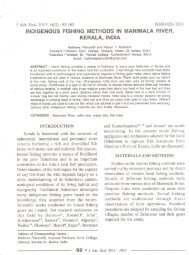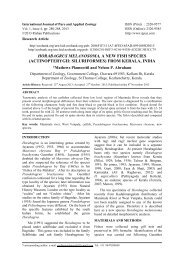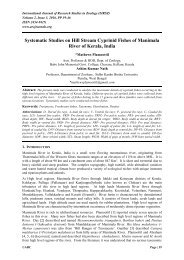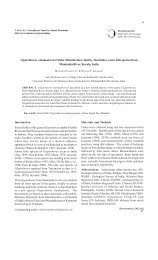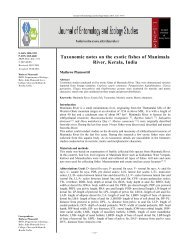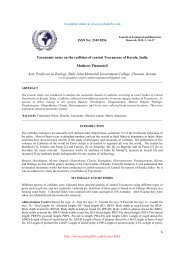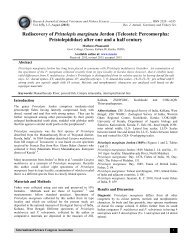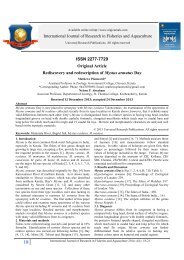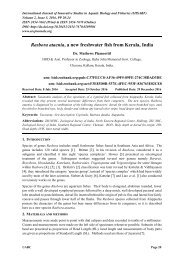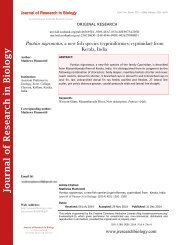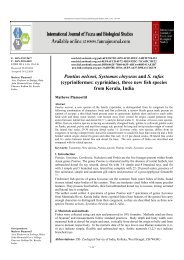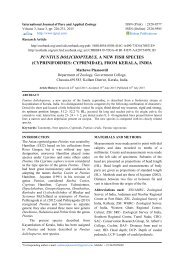Create successful ePaper yourself
Turn your PDF publications into a flip-book with our unique Google optimized e-Paper software.
Journal of Research in Biology<br />
Journal of Research in Biology<br />
ISSN No: Print: 2231 –6280; Online: 2231- 6299<br />
An International Scientific Research Journal<br />
<strong>Batasio</strong> <strong>flavus</strong>, a new catfish species (Siluriformes: Bagridae) from Kerala,<br />
India<br />
Author:<br />
Mathews Plamoottil<br />
Institution:<br />
Assistant Professor in<br />
Zoology, Baby John<br />
Memorial Government<br />
College,<br />
Chavara, Kollam Dt, Kerala.<br />
Original research<br />
urn:lsid:zoobank.org:pub:0DE67D47-28C9-4435-A8FD-D70EEA6A47ED<br />
urn:lsid:zoobank.org:act:09D3BF5E-C465-4FC2-9B8F-88CAB90C56DC<br />
ABSTRACT:<br />
<strong>Batasio</strong> <strong>flavus</strong>, a new species of the family Bagridae, is described from<br />
Manimala River of Kerala, India. It is distinguished from its relative species by the<br />
following combination of characters: body slender, dorsal profile nearly straight; body<br />
and fins yellow; median longitudinal groove on head narrow, single and extending to<br />
base of occipital process; occipital process very short, equal to the length of orbit and<br />
never reach basal bone of dorsal fin; orbits are widely set; dorsal fin spine very weak,<br />
feebly ossified and its anterior and posterior edges smooth; considerable distance<br />
between base of last rayed dorsal fin ray and origin of adipose dorsal fin. The second<br />
dorsal fin with a straight margin for entire length. The new fish species is described<br />
and compared with its related species.<br />
Keywords:<br />
Bagrids, New species, Manimala River, <strong>Batasio</strong> travancoria, B. sharavatiensis<br />
Corresponding author:<br />
Mathews Plamoottil<br />
Email Id:<br />
Web Address:<br />
http://jresearchbiology.com/<br />
documents/RA0520.pdf<br />
Journal of Research in Biology<br />
An International<br />
Scientific Research Journal<br />
Article Citation:<br />
Mathews Plamoottil.<br />
<strong>Batasio</strong> <strong>flavus</strong>, a new catfish species (Siluriformes: Bagridae) from Kerala, India<br />
Journal of Research in Biology (2015) 5(5): 1799-1808<br />
Dates:<br />
Received: 17 November 2014 Accepted: 30 June 2015 Published: 18 August 2015<br />
This article is governed by the Creative Commons Attribution License (http://creativecommons.org/<br />
licenses/by/4.0), which gives permission for unrestricted use, non-commercial, distribution and<br />
reproduction in all medium, provided the original work is properly cited.<br />
1799-1808 | JRB | 2015 | Vol 5 | No 5<br />
www.jresearchbiology.com
Plamoottil, 2015<br />
INTRODUCTION<br />
The species of genus <strong>Batasio</strong> Blyth, 1860 are<br />
small to medium-sized bagrid catfishes found in South<br />
and Southeast Asia. They are diagnosed from other<br />
members of the Bagridae in possessing large sensory<br />
pores on head, a pair of prominent posterior processes on<br />
the anterior part of the vomer, narrow mental region,<br />
transversely elongated, bar-like entopterygoid (Mo,<br />
1991) and also in possessing small barbels.<br />
<strong>Batasio</strong> batasio (Hamilton, 1822), B. tengana<br />
(Hamilton, 1822), B. affinis Blyth (1860), B. fluviatilis<br />
(Day, 1888), B. dayi (Vinciguerra, 1890), B.<br />
merianiensis (Chaudhuri, 1913; Ng, 2009; Tamang &<br />
Sinha, 2014), B. travancoria Hora & Law (1941), B.<br />
pakistanicus Mirza & Jan (1989), B. tigrinus Ng &<br />
Kottelat (2001), B. elongatus Ng (2004), B.<br />
sharavatiensis Bhatt & Jayaram (2004), B. macronotus<br />
Ng & Edds (2004), B. fasciolatus Ng (2006), B. spilurus<br />
Ng (2006), B.`feruminatus Ng & Kottelat (2007), B.<br />
procerus Ng (2008) and B. convexirostrum Darshan<br />
et al., (2011) are the valid <strong>Batasio</strong> species (Misra, 1976;<br />
Ng & Kottelat, 2001; Jayaram, 2006, 2010; Ng, 2008<br />
& Darshan et al., 2011). <strong>Batasio</strong> travancoria Hora &<br />
Law and B. sharavatiensis Bhatt & Jayaram are the two<br />
<strong>Batasio</strong> species described from south India. <strong>Batasio</strong><br />
travancoria is the only one species of <strong>Batasio</strong> residing in<br />
the water bodies of Kerala. During a recent survey of<br />
Manimala River of Kerala, India, a yellowish colored<br />
species of <strong>Batasio</strong> was obtained, which on comparison<br />
with its congeners was found to be undescribed. It is<br />
described here as a new species <strong>Batasio</strong> <strong>flavus</strong>.<br />
MATERIALS AND METHODS<br />
Measurements were made point to point with dial<br />
calipers and data recorded to tenths of a millimeter.<br />
Counts and measurements were made on the left side of<br />
specimens whenever possible. Subunits of the head are<br />
presented as proportions of head length (HL); head<br />
length and measurements of body parts are given as<br />
proportions of standard length (SL). Methods used are<br />
those of Jayaram (2002).<br />
Abbreviations used: ZSI/ANRC - Zoological Survey of<br />
India, Andaman & Nicobar Regional Centre, Haddo,<br />
Port Blair, Andaman & Nicobar Islands;<br />
ZSI - Zoological Survey of India, Kolkata; ZSI / SRC -<br />
Zoological Survey of India, Southern Regional Centre,<br />
Chennai; IOW - Inter Orbital Width; LBAD - Length of<br />
Base of Adipose Dorsal fin; AD - Adipose Dorsal fin;<br />
RD - Rayed Dorsal fin; BDD - Body Depth at rayed<br />
Dorsal front; BDA - Body Depth at Anal front;<br />
DCP - Depth of Caudal Peduncle; HD - Head Depth;<br />
HL - Head Length; CL - Caudal Lobe; HADA - Height<br />
of Adipose Dorsal at Anal front.<br />
BATASIO FLAVUS, SP. NOV<br />
(Figures. 1- 3; Table 1)<br />
Holotype: ZSI/ANRC - 12228, 81.0 mm SL, India:<br />
Kerala, Manimala River at Paduthode, coll. Mathews<br />
Plamoottil, 11 January 2012.<br />
Paratypes: ZSI/ANRC - 12229, 3 specimens, 69.0-88.0<br />
mm SL, India: Kerala, Manimala River at Paduthode,<br />
coll. Mathews Plamoottil, 11 January 2012.<br />
Diagnosis<br />
The new species can be distinguished from its<br />
congeners in having a slender (BDD 16.0-18.0 % SL)<br />
body; body and fins yellowish; dorsal profile nearly<br />
straight; single median longitudinal groove on head;<br />
occipital process very small and hidden under skin;<br />
adipose dorsal fin with a straight margin for entire length<br />
and inserted behind a considerable distance from rayed<br />
dorsal fin; head flatter (HD 53.0-57.1 % SL) and orbits<br />
widely set (IOW 27.0-31.3 % HL).<br />
Description<br />
Morphometric data as in Table 1. Body<br />
elongated and moderately compressed. Dorsal profile<br />
rising evenly and gradually from the tip of snout to the<br />
origin of dorsal fin, then going in a roughly straight line<br />
to caudal fin base, except a concavity in front and behind<br />
adipose dorsal fin. Ventral profile flat up to posterior end<br />
1800 Journal of Research in Biology (2015) 5(5): 1799-1808
Plamoottil, 2015<br />
Fig. 1. A fresh specimen of <strong>Batasio</strong> <strong>flavus</strong>, sp.nov, Paratype, ZSI/ANRC- 12229<br />
Fig. 2. <strong>Batasio</strong> <strong>flavus</strong>, sp.nov, Holotype, ZSI/ANRC - 12228<br />
Fig.3. Head region of <strong>Batasio</strong> <strong>flavus</strong>, sp.nov<br />
of anal fin base, then sloping slightly to the end of caudal<br />
peduncle. Urino - genital opening located at anterior 1/3<br />
from the origin of ventral fin; anal opening fairly in front<br />
of anal fin origin.<br />
Skin smooth, lateral line complete and mid<br />
lateral. Head compressed, conical, rounded anteriorly;<br />
bony elements on the dorsal surface of head are covered<br />
with thin skin. Snout rounded projecting over the mouth;<br />
nostrils wide apart; anterior nostrils tubular and located<br />
at the base of maxillaries, separated from the posterior<br />
nostrils by a distance equal to the diameter of the orbit.<br />
Median longitudinal groove on the head narrow, single,<br />
extending to base of occipital process; occipital process<br />
very short, equal to length of orbit and never reach basal<br />
bone of dorsal fin; an inter neural shield present between<br />
occipital process and dorsal fin; occipital process cannot<br />
be seen externally as this part is covered by a thick flesh.<br />
Mouth small, inferior, lunate, crenulated and continuous<br />
at the angles of the mouth. Eyes ovoid, dorso- lateral,<br />
horizontal axis longest. Pores present between nostrils,<br />
before eyes and along free borders of gill covers; 4-5<br />
large pores from angle of mouth to opercle.<br />
Mouth sub terminal; premaxillary teeth not<br />
exposed when mouth is closed. Oral teeth villiform on all<br />
Journal of Research in Biology (2015) 5(5): 1799-1808 1801
Plamoottil, 2015<br />
teeth bearing surfaces. Barbels four pairs; maxillary<br />
barbels short, slender, extending to middle of orbit, never<br />
reach pectoral base or outer opercular margin, reach half<br />
way to pectoral base. Nasal barbels slender, fairly reach<br />
anterior margin of orbit. Inner mandibulars very short<br />
and feeble, origin on either side of mid ventral line, its<br />
length ¾ of the diameter of orbit. Outer mandibulars<br />
originate posterio - lateral to inner mandibulars, reach in<br />
vertical just behind anterior margin of orbit.<br />
Dorsal fin with a small spine and seven branched<br />
rays. Origin of dorsal fin above the middle of pectoral fin<br />
in smaller ones and at the tip of pectoral in larger ones.<br />
Dorsal fin margin convex. Tip of dorsal fin reach the tip<br />
of pelvic fin or 2/3 of length pelvic fin from its origin.<br />
Dorsal fin spine straight, slender, very weak, feebly<br />
ossified and flexible, anterior and posterior edges<br />
smooth. Pectoral fin with a moderately strong spine and<br />
7-8 rays. Anterior margin of spine smooth, posterior<br />
margin with 10-13 small moderate serrations along entire<br />
length. Adipose dorsal fin with a straight margin for<br />
entire length, its anterior end never reach the base of last<br />
dorsal fin ray, but reach above the tip of pelvic fin or a<br />
little in front of the tip of pelvic fin. Considerable<br />
distance between base of last dorsal fin ray and origin of<br />
adipose dorsal fin. Adipose dorsal fin base extending to<br />
about ½ of an eye diameter behind last anal ray. Inter<br />
dorsal distance 8.0-12.3 in percent of SL and 41.7-47.6<br />
in percent of adipose dorsal fin base. Pectoral fin margin<br />
convex posteriorly. Tip of pectoral fin just reach or reach<br />
a little behind the level of origin of dorsal fin. Pelvic fin<br />
origin at vertical through posterior end of dorsal fin base<br />
and with, 5 rays and with a convex margin. Tip of it<br />
reach below anterior end of adipose dorsal fin base or a<br />
little behind it, it never reach anal fin origin but reach or<br />
reach nearer to the anal opening. Anus and urino genital<br />
openings are located on the mid ventral line in between<br />
ventral fin and anal fin origin.<br />
Origin of anal fin base in a vertical through ¼ of<br />
the length of adipose dorsal fin from its anterior end,<br />
located nearer to pelvic fin than to caudal fin base, with<br />
four undivided rays and 9-10 branched rays. Distal<br />
margin of anal fin slightly convex. Tip of anal fin never<br />
reach caudal fin base. Caudal peduncle depth 50.0-53.5<br />
in percent of its length. Caudal fin deeply forked with<br />
rounded lobes having 17 principal rays.<br />
Coloration: Body and fins yellow; a small brownish<br />
black triangular spot present in front of rayed dorsal fin<br />
base; a triangular dark or light brownish black spot<br />
present on caudal base. A thin brownish black line passes<br />
through mid lateral line.<br />
Etymology: The specific epithet ‘<strong>flavus</strong>’ is a Latin word<br />
meaning ‘light yellow’ refers to the color of the body of<br />
the new fish.<br />
Distribution: Currently known to occur only at<br />
Paduthode of Manimala River, Kerala, India.<br />
Habitat: The river stretch of Manimala River at<br />
Paduthode, the type locality of <strong>Batasio</strong> <strong>flavus</strong>, is<br />
generally occupied by sand or sandy gravel with<br />
occasional presence of bed rock or black clays. Width<br />
and depth in this area are 45.0-125.0 m and 0.3-6 m<br />
respectively; the bank height is 4.0-5.0 m above the<br />
general water level in summer season. The area is<br />
blanketed by moderate to dense riparian vegetation;<br />
intermittent occurrence of low riparian vegetation<br />
noticed at certain places.<br />
DISCUSSION<br />
The new species differs from <strong>Batasio</strong><br />
travancoria Hora & Law (1941) of Pamba and Kallada<br />
Rivers of Kerala in many characters; In <strong>Batasio</strong><br />
travancoria body is grey or brown (vs. yellow in new<br />
species), median cephalic groove appear as double<br />
fontanels (vs. single), occipital process can be seen<br />
externally (vs. not seen externally) and adipose dorsal fin<br />
originates immediately behind the rayed dorsal fin (vs.<br />
AD inserted behind a considerable distance from RD).<br />
New species have a slender body (BDA 14.0-14.8 % SL<br />
vs. 14.8-17.3 in B. travancoria), flatter head (HD 11.1-<br />
1802 Journal of Research in Biology (2015) 5(5): 1799-1808
Plamoottil, 2015<br />
Table 1. Morphometric characters of <strong>Batasio</strong> <strong>flavus</strong><br />
Sl.No. Characters HT Range Mean SD<br />
1 Total length (mm) 98.5 82.0-106.0 95.8 8.7<br />
2 Standard length (mm) 81.0 69.0-88.0<br />
79.8 7.8<br />
% of SL<br />
3 Head length 22.8 21.0-23.8<br />
4 Head depth 12.3 11.1- 13.6<br />
5 Head width 15.4 14.2- 17.0<br />
22.7 1.0<br />
12.5 1.1<br />
15.7<br />
1.2<br />
6 Post orbital length 10.0 9.6- 10.6 10.0<br />
7 Head length excluding snout 17.3 16.5- 17.3 17.0<br />
1.0<br />
1.0<br />
8 Body depth at dorsal origin 16.0 16.0-18.0<br />
9 Body depth at anal origin 14.2 14.0-14.8<br />
17.1<br />
14.6<br />
0.8<br />
0.3<br />
10 Body width at dorsal origin 13.0 12.8-14.8<br />
13.975 0.8<br />
11 Body width at anal origin 9.8 7.2-9.9<br />
8.4 1.1<br />
12 Pre dorsal length 34.0 32.6-35.8<br />
34.1 1.3<br />
13 Post dorsal length 63.2 63.0-65.2<br />
63.9 0.9<br />
14 Pre pectoral length 22.8 21.7-23.9<br />
22.7 0.9<br />
15 Pre pelvic length 48.1 45.0-50.0<br />
47.7 2.1<br />
16 Pre anal length 67.3 65.0-68.0<br />
66.6 1.3<br />
17 Length of rayed dorsal 16.0 13.6-17.6<br />
15.3 1.9<br />
18 Height of adipose dorsal 4.8 3.0- 5.0<br />
4.4 0.9<br />
19 Length of pectoral 17.0 14.8-17.3<br />
16.0 1.0<br />
20 Length of pelvic 14.7 12.3-14.8<br />
13.2 1.3<br />
21 Length of anal 11.3 11.1-12.5<br />
11.9 0.9<br />
22 Length of dorsal spine 13.5 11.1-13.7<br />
14.2 1.2<br />
23 Length of pectoral spine 14.6 11.6-14.8 16.0<br />
1.5<br />
24<br />
Length of upper caudal lobe<br />
18.5 18.2-21.7<br />
19.2 1.7<br />
25<br />
Length of lower caudal lobe<br />
21.6 19.8-21.7<br />
20.9 0.9<br />
Journal of Research in Biology (2015) 5(5): 1799-1808 1803
Plamoottil, 2015<br />
26 Length of base of rayed dorsal 13.3 13.1-14.5<br />
13.6 0.3<br />
27 Length of base of adipose dorsal 26.5 25.0-29.0<br />
26.6 1.7<br />
28 Length of base of pectoral 4.0 3.6-4.3<br />
4 0.4<br />
29 Length of base of pelvic 3.7 3.3-4.1<br />
3.6 0.2<br />
30 Length of base of anal 14.8 14.2-16.0 14.9<br />
0.8<br />
31 Length of base of caudal 12.3 11.1-13.9<br />
12.6 1.2<br />
32 Length of caudal peduncle 18.5 17.2-21.7<br />
18.7 2.1<br />
33 Depth of caudal peduncle 9.8 8.6-11.6<br />
9.8 1.3<br />
34 Width of caudal peduncle 3.7 2.9-3.8<br />
3.5 0.4<br />
35<br />
Distance from pectoral to pelvic<br />
26.5 24.6-29.6<br />
26.7 4.4<br />
36 Distance from pelvic to anal 19.7 17.6-20.3<br />
19.0 1.2<br />
37<br />
Distance from anal to caudal<br />
30.5 29.7-31.8 30.5 1.8<br />
38 Distance from adipose dorsal to caudal<br />
14.8 14.2-15.0 15.0 1.1<br />
39 Distance from rayed dorsal to adipose dorsal<br />
11.1 8.0-12.3 9.6 1.0<br />
40 Distance from anal to vent<br />
1.5 1.5- 2.6 2.0 0.1<br />
41 Distance from ventral to vent<br />
17.9 15.2- 17.9 16.0 2.0<br />
42<br />
Head length (mm) 18.5 16.0-21.0<br />
18.1 2.2<br />
% of HL<br />
43 Head depth 54.1 53.0-57.1<br />
55.1 2.1<br />
44 Head width 67.6 67.5-71.4<br />
68.8 1.8<br />
45<br />
Distance from occiput to snout<br />
91.3 89.2-94.1<br />
91.1 2.1<br />
46<br />
Distance from occiput to dorsal origin<br />
59.4 57.1-73.5<br />
63.1<br />
7.3<br />
47<br />
Length of frontal groove<br />
60.0 56.8- 76.5<br />
68.2 10.2<br />
50 Eye diameter 27.0 23.5-28.1<br />
25.6 1.9<br />
51 Inter orbital width 27.1 27.0-31.3<br />
28.7 1.8<br />
52 Inter narial width 26.0 19.0-27.0<br />
23.6 4.0<br />
53 Snout length 37.8 31.3-38.0<br />
35.1 3.3<br />
1804 Journal of Research in Biology (2015) 5(5): 1799-1808
Plamoottil, 2015<br />
54 Width of gape of mouth 27.0 25.0-30.6<br />
55 Length of maxillary barbels 32.8 32.4-47.1<br />
56 Length of nasal barbels 16.2 16.2-19.0<br />
57 Length of outer mandibular barbels 11.7 10.8-20.6<br />
58 Length of inner mandibular barbels 10.5 9.7-17.6<br />
Ratios<br />
59 Standard length/ Head length 4.4 4.0-4.8<br />
60 Standard length/ Body depth 5.9 5.1-6.2<br />
61<br />
Body depth/ Body width<br />
1.3 1.2- 1.4<br />
28.2 2.3<br />
37.6 6.7<br />
17.9 1.3<br />
16.8 5.3<br />
13.9 3.9<br />
4.3 0.4<br />
5.7 0.5<br />
1.3 0.1<br />
62<br />
63<br />
Length of base o AD/Length of base of RD<br />
Length o base of AD/Inter dorsal distance<br />
1.9 1.7- 2.0<br />
2.4 2.1- 2.6<br />
64 Length o base of RD/ Inter dorsal distance 1.2 1.1-1.6<br />
65 LBAD/HADA 6.3 6.0-9.1<br />
66 Head length/length of rayed dorsal fin 1.4 1.4- 1.6<br />
67 Head length/height of adipose dorsal fin 5.3 4.6- 6.0<br />
68 Head length/Length of pectoral fin 1.3 1.3-1.6<br />
69 Head length/Length of pelvic fin 1.7 1.5- 1.9<br />
70 Head length/Length of anal fin 1.9 1.7- 2.1<br />
71<br />
Length of base of AD/Length of base of anal fin<br />
1.8 1.7-1.8<br />
72<br />
Length of caudal peduncle/depth of caudal<br />
peduncle 1.9 1.5- 2.0<br />
1.8 0.1<br />
2.4 0.2<br />
1.2 0.2<br />
7.1 1.4<br />
1.5 0.1<br />
5.4 0.6<br />
1.4 0.2<br />
1.7 0.2<br />
1.9 0.2<br />
1.8 0.1<br />
1.8 0.2<br />
73<br />
Length of upper caudal lobe/Length of lower CL<br />
.9 .9-1.0<br />
0.9 0.1<br />
74<br />
Inter orbital width /Eye diameter<br />
1.1 1.0-1.3 1.1<br />
0.1<br />
75<br />
Snout length/Eye diameter<br />
1.4 1.4- 1.8<br />
1.6 0.2<br />
76 Snout length/Inter orbital width 1.4 1.2-1.8<br />
1.4 0.3<br />
13.6 % SL vs. 14.8-15.6), smaller eyes (23.5-28.1 % HL<br />
vs. 32.2 - 36.8), anterior and posterior edges of dorsal<br />
spine smooth (vs. both edges feebly serrated), short<br />
based adipose dorsal fin (25.0-29.0 % SL vs. 36.4-40.2)<br />
and longer caudal peduncle (17.2-21.7% SL vs. 11.1-<br />
13.5). <strong>Batasio</strong> <strong>flavus</strong> can be distinguished from<br />
B. sharavatiensis Bhatt & Jayaram (2004) of Karnataka<br />
in having a short based adipose dorsal fin which starts<br />
after a considerable distance from rayed dorsal fin (vs.<br />
long based AD which originates immediately after RD in<br />
B. sharavatiensis), anal fin with lesser number of<br />
branched rays (9-10 vs. 12-14), slender body (BDD 16.0-<br />
18.0 % SL vs. 18.2-23.3), shorter head (21.0-23.8 % SL<br />
vs. 26.4-28.6) and larger eyes (23.5-28.1 % HL vs. 17.2-<br />
18.7).<br />
<strong>Batasio</strong> merianiensis (Chaudhuri, 1913) of<br />
Assam can be distinguished from B. <strong>flavus</strong> in having a<br />
deeper body (BDA 15.2-18.4 % SL vs. 14.0-14.8),<br />
Journal of Research in Biology (2015) 5(5): 1799-1808 1805
Plamoottil, 2015<br />
vertical dark brown bars on head and body (vs. absent in<br />
the new species), and short based adipose dorsal fin (16.9<br />
-22.2 % SL vs. 25.0-29.0). <strong>Batasio</strong> convexirostrum<br />
Darshan et al., (2011) of Mizoram can be distinguished<br />
from the new species in having a pre dorsal bar (vs.<br />
absent in B. <strong>flavus</strong>), longer snout (39.2-45.5 % HL vs.<br />
31.3-38.0), very short inter dorsal distance (1.7-4.1 % SL<br />
vs. 8.0-12.3), long based adipose dorsal fin (31.0-34.9 %<br />
SL vs. 25.0-29.0) and pectoral fin with more branched<br />
rays (9-10 vs. 7-8). <strong>Batasio</strong> niger Vishwanath & Darshan<br />
(2006) of Manipur was considered as a junior subjective<br />
synonym of B. havmolleri by Ng & Kottelat (2007). The<br />
former differs from the new species in having a body<br />
with a black oblique pre dorsal bar (vs. absent in B.<br />
<strong>flavus</strong>), deeper body (BDA 18.4-24.8 % SL vs. 14.0-<br />
14.8) and higher head (16.7-22.3 % SL vs. 11.1-13.6).<br />
<strong>Batasio</strong> fasciolatus Ng (2006) of west Bengal can be<br />
differentiated from B. <strong>flavus</strong> in having 5-6 vertical dark<br />
brown bands (vs. absent in the new species), deeper body<br />
(BDA 18.1-20.3 % SL vs. 14.0-14.8), longer dorsal spine<br />
(13.6-16.8 % SL vs. 11.1-13.7) and smaller eyes (16.5-<br />
16.8 % HL vs. 23.5-28.1). <strong>Batasio</strong> spilurus Ng (2006) of<br />
Assam differs <strong>Batasio</strong> <strong>flavus</strong> in having a longer (26.9-<br />
28.6 % SL vs. 21.0-23. 8.), deeper (15.7-17.0 % S L vs.<br />
11.1-13.6) head and short based adipose dorsal fin (12.6-<br />
12.8 % SL vs. 25.0-29.0). <strong>Batasio</strong> fluviatilis (Day, 1888;<br />
Ng & Kottelat, 2007) differs from the new species in<br />
having a dark oblique predorsal bar and a dark spot on<br />
the sides of the body below the middle of the adipose-fin<br />
base (vs Absent in B. <strong>flavus</strong>) and a long based adiposefin<br />
(30.0-33.3 % SL vs. 25.0-29.0). <strong>Batasio</strong> tengana<br />
Hamilton (1822) of Brahmaputra River differs from B.<br />
<strong>flavus</strong> in having a dark mid dorsal stripe (vs. absent in B.<br />
<strong>flavus</strong>), elongated head (23.8-28.8 % SL vs. 21.0-23.8),<br />
shorter based adipose dorsal fin (14.5-17.5 % SL vs. 25.0<br />
-29.0) and slender caudal peduncle (DCP 6.7- 8.2 % SL<br />
vs. 8.6-11.6). <strong>Batasio</strong> batasio (Hamilton-Buchanan)<br />
(1822) of West Bengal have an elliptical dark brown spot<br />
below dorsal fin base (vs. absent in B. <strong>flavus</strong>), mottled<br />
pattern of faint brown patches on body (vs. absent),<br />
deeper head (16.3-21.2 % SL vs. 11.1-13.6), longer<br />
snout (43.9-46.2 % HL vs. 31.3-38.0), double (vs. single)<br />
cephalic fontanels and occipital process reaching basal<br />
bone of dorsal fin (vs. never reach).<br />
CONCLUSION<br />
<strong>Batasio</strong> species are obligate inhabitants of<br />
headwater streams and the upper reaches of smaller<br />
rivers characterized by fast-flowing, shallow, well<br />
oxygenated stretches of riffles and run broken up by<br />
pools or cascades in some cases. They prefer to live in<br />
small streams with rocky or sandy bottom. Taxonomic<br />
studies undergoing on these fishes are rare; it is mainly<br />
because they are not abundantly distributed in the large<br />
rivers where fishing practices are common; they are<br />
considered as weed fishes as they are not edible; as size<br />
is small they cannot be caught by the common gill nets<br />
and cast nets; their number may also be less. It was only<br />
in 1941 the first <strong>Batasio</strong> species discovered from Kerala.<br />
Now it is after 74 years a second <strong>Batasio</strong> species reaches<br />
to scientific world from Kerala. The new species,<br />
<strong>Batasio</strong> <strong>flavus</strong> is a unique <strong>Batasio</strong> species with many<br />
peculiar characters unseen in its congeners; they require<br />
spotless and clear water and are intolerant to the<br />
accumulation of organic wastes and other contaminants.<br />
Regular monitoring of the water quality is essential for<br />
the protection and preservation of this rare species.<br />
Comparative materials Examined<br />
<strong>Batasio</strong> travancoria: ZSI 13449/1, Holotype, 73.6 mm<br />
SL; India: Travancore, from the foot of the largest falls<br />
of Peruntenaruri, a tributary of the Pamba River at<br />
Edakadathy. 2 ex. 59.0, 65.0 mm SL, Kulathoopzha,<br />
Kallada River. ZSI 13452/1, 1 ex., 58.1 mm SL; India:<br />
Travancore, Palode, Chittar River.<br />
<strong>Batasio</strong> sharavatiensis: Holotype: ZSI/ SRC F 6419, 99<br />
mm SL, Joginmatha, Uttara Kannada, Karnataka, coll.<br />
Anuradha Bhatt, 08. 03. 1998. Paratypes: ZSI/ SRC F<br />
6420, 104.0 mm SL, Joginmatha, Sharavathi River,<br />
1806 Journal of Research in Biology (2015) 5(5): 1799-1808
Plamoottil, 2015<br />
Uttara Kannada, Karnataka, coll. Anuradha Bhatt, 18. 3.<br />
1999.<br />
<strong>Batasio</strong> merianiensis: ZSI F 7781/1, 1 ex., holotype,<br />
65.7 mm SL; India: NE Assam, Meriani. Taxonomic<br />
details were taken from original descriptions and revision<br />
for other species of <strong>Batasio</strong> found outside South India.<br />
ACKNOWLEDGMENTS<br />
The author acknowledges Principal, Baby John<br />
Memorial Government College, Chavara, Kerala for<br />
providing the facilities. I am grateful to anonymous<br />
reviewers for comments that helped to improve the<br />
manuscript.<br />
REFERENCES<br />
Bhatt A and Jayaram KC. 2004. A new species of the<br />
genus <strong>Batasio</strong> Blyth (Siluriformes: Bagridae) from<br />
Sharavati River, Uttara Kannada, Karnataka. Zoosprint<br />
Journal. 19(19): 1339- 1342.<br />
Blyth E. 1860. Report on some fishes received chiefly<br />
from the Sitang River and its tributary streams,<br />
Tenasserim Provinces. Journal of the Asiatic Society<br />
(Bengal. 29(2): 138-174.<br />
Chaudhuri BL. 1913. Zoological results of the Abor<br />
Expedition, 1911–12. XVIII. Fish. Records of the Indian<br />
Museum. 8(3): 243-257, Pls. 7-9.<br />
Darshan AN, Anganthoibi and Vishwanath W. 2011.<br />
<strong>Batasio</strong> convexirostrum, a new species of catfish<br />
(Teleostei: Bagridae) from Koladyne basin, India.<br />
Zootaxa. 2901: 52-58.<br />
Day F. 1888. Supplement to the fishes of India; being a<br />
natural history of the fishes known to inhabit the seas<br />
and fresh waters of India, Burma, and Ceylon. Williams,<br />
London & Norgate, Edinburg, 779-816.<br />
Hamilton B. 1822. An account of the fishes found in the<br />
River Ganges and its branches. Archibald Constable,<br />
Edinburgh and Hurst, Robinson, London, 405.<br />
Hora SL and Law NC. 1941. Siluroid fishes of India,<br />
Burma and Ceylon. IX. Fishes of the genera Gagata<br />
Bleeker and Nangra Day. X. Fishes of the genus <strong>Batasio</strong><br />
Blyth. Records of the Indian Museum. 43, 9-42.<br />
Jayaram KC. 2002. Fundamentals of Fish Taxonomy.<br />
Narendra publishing House, Delhi.174.<br />
Jayaram KC. 2006. Cat Fishes of India. Narendra<br />
Publishing House, Delhi. 383.<br />
Jayaram KC. 2010. Freshwater fishes of the Indian<br />
Region. Narendra publishing House, Delhi. 256-260.<br />
Mirza MA. and Jan MA. 1989. <strong>Batasio</strong> pakistanicus<br />
new species, a new catfish (Pisces, Bagridae) from<br />
Pakistan. Scientific Khyber. 2: 283-286.<br />
Mo TP. 1991. Anatomy, relationships and systematics of<br />
the bagridae (Teleostei: Siluroidei) with a hypothesis of<br />
siluroid phylogeny. Theses Zoologicae, Koeltz,<br />
Koenigstein. 216p.<br />
Misra KS. 1976. The fauna of India and Adjacent<br />
countries. Zool. Sur. India, Kolkata. 367.<br />
Ng HH and Kottelat M. 2001. A review of the genus<br />
<strong>Batasio</strong> in Indochina with the description of B. tigrinus<br />
from Thailand. Rev. Suisse Zool. 108(3): 495-511.<br />
Ng HH. 2004. <strong>Batasio</strong> elongatus, a new species of<br />
bagrid catfish from southwest Myanmar (Siluriformes:<br />
Bagridae). Ichthyol. Explor. Freshwaters. 15(1): 67-70.<br />
Ng HH and Edds DR. 2004. <strong>Batasio</strong> macronotus, a new<br />
species of bagrid catfish from Nepal (Teleostei:<br />
Bagridae). Ichthyol. Explor. Freshwaters. 15(4): 295-<br />
300.<br />
Ng HH. 2006. The identity of <strong>Batasio</strong> tengana with<br />
description of two new species of <strong>Batasio</strong> from north<br />
eastern India. Journal of fish Biology. 68: 101-118.<br />
Ng HH. 2008. <strong>Batasio</strong> procerus, a new species of catfish<br />
Journal of Research in Biology (2015) 5(5): 1799-1808 1807
Plamoottil, 2015<br />
from northern Myanmar (Siluriformes: Bagridae).<br />
Ichthyological Exploration of Freshwaters. 19(1): 1-6.<br />
Ng HH and Kottelat M. 2007. <strong>Batasio</strong> feruminatus, a<br />
new species of bagrid catfish from Myanmar<br />
(Siluriformes: Bagridae), with notes on the identity of B.<br />
affinis and B. fluviatilis. Ichthyol. Explor.<br />
Freshwaters. 18: 289-300.<br />
Ng HH. 2009. Redescription of <strong>Batasio</strong> merianiensis, a<br />
catfish (Teleostei: Bagridae) from northeastern India,<br />
Journal of Threatened Taxa. 1(5): 253-256.<br />
Tamang L and Sinha B. 2014. Additional record of<br />
<strong>Batasio</strong> merianiensis (Chaudhuri 1913), a catfish<br />
(Teleostei: Bagridae) in upper Brahmaputra River<br />
drainage in Arunachal Pradesh, India. Journal of<br />
Threatened Taxa. 6(5): 5738-5743.<br />
Vinciguerra D. 1890. Viaggio di Leonardo fea in<br />
Birmania regione vicini (Pesci). Ann. Mus. Civ. Storia<br />
nat. Genoa. 9(2): 129-362.<br />
Vishwanath W and Darshan A. 2006. A new species of<br />
the genus <strong>Batasio</strong> Blyth from Manipur, India. Zoosprint<br />
Journal. 21(2): 2160-2163.<br />
Submit your articles online at www.jresearchbiology.com<br />
Advantages<br />
Easy online submission<br />
Complete Peer review<br />
Affordable Charges<br />
Quick processing<br />
Extensive indexing<br />
You retain your copyright<br />
submit@jresearchbiology.com<br />
www.jresearchbiology.com/Submit.php<br />
1808 Journal of Research in Biology (2015) 5(5): 1799-1808




